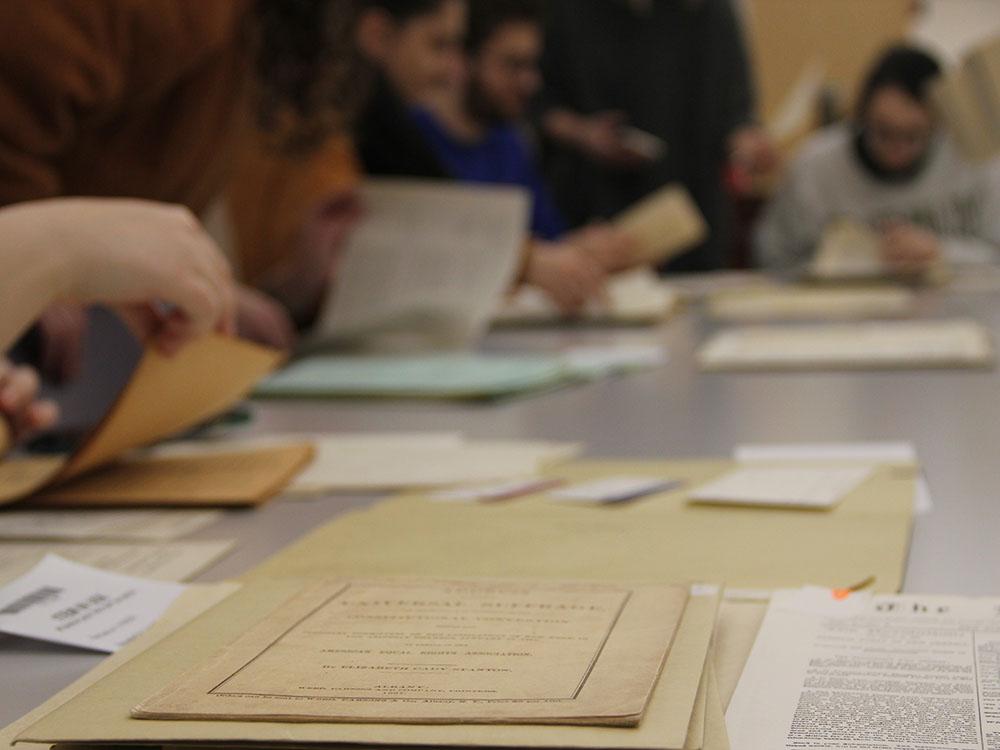Learning Outcomes for Special Collections Instruction
Our instruction program centers on teaching primary source literacy, which is the ability to identify, find, and evaluate primary sources. Our unique collections showcase various subjects including 19th and 20th century American History, Race and Gender Studies, Music and Performing Arts History, Japanese History, Media Studies, Labor History, and the history of the state of Maryland. In addition to providing immersive instruction sessions, we enjoy working with instructors to develop teaching materials or assignments for their students.
Our menu of services include

- Hosting single class visits
- Curating selections of our material which can be served to learners in our library or online
- Designing instructional material, such as lesson plans, slide decks, or syllabi
- Creating course or subject-specific Research Guides
- Providing tours
- Tours are designed to accommodate each group's specific interests and learning goals; email us to learn more about tour options.
Learning Outcomes
Scholarship as conversation
Learners will be able to distinguish primary from secondary sources and describe how these sources interrelate within research. Learners will be able to synthesize a variety of primary and secondary sources to construct, support, or dispute a research argument, and be able to distinguish between research tools with information about sources and the sources themselves. Learners will use primary sources to contribute to the scholarly conversation in creative ways, which may include works of art, oral histories, and/or traditional research products, such as papers.
Searching as strategic exploration
Learners will recognize that archival research is an iterative process which includes defining an information need within a historical or cultural context, initiating and refining a search strategy, and seeking alternative points of view on a topic. Learners will employ increasingly specialized research techniques which may include use of archival databases, finding aids, and other research tools. Learners will recognize how their own perspectives and different research methodologies influence their search process.
Authority is constructed and contextual
Learners will be able to evaluate the record creator's perspective and identify their connection(s) to the purpose and audience of a primary source. Learners will consider the reasons for silences, contradictions, and power relationships within archival collections and articulate how these may impact both the value of the source and the archival research process. As a result of engaging in primary source research, learners will develop historical empathy, curiosity, and an appreciation for primary sources.
Information creation as a process
Learners will be able to examine a primary source and articulate how its different components such as handwriting, language, and the technology used to create the source may reveal its provenance and contribute to the perceived value of the primary source. Learners will be able to recognize that primary sources may exist in a broad array of formats including both original documents as well as digital and print copies.
Research as inquiry
Learners will be able to discover specific primary sources for research within a specific discipline. Learners will be able to demonstrate a sense of curiosity when defining a research question with the understanding that research is a fluid process that is subject to change. Learners will be able to recognize the possible limitations of archival research, which include an understanding that records may not exist or be publicly available, and that the creation, survival, and access to archival collections is mediated by human actors.
Information has value
Learners will be able to describe the unique ethical and legal considerations of using primary sources when conducting archival research. Learners will respect privacy rights, copyright laws, and the cultural context of a source, and cite sources following the attribution standards for their specific discipline. Learners will be able to identify the connection between a primary sources’ content and its physical format.